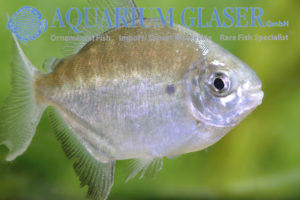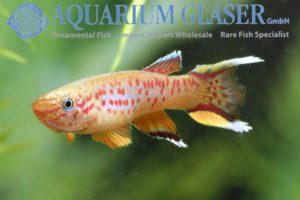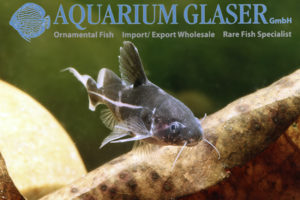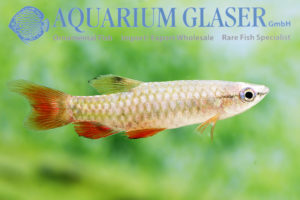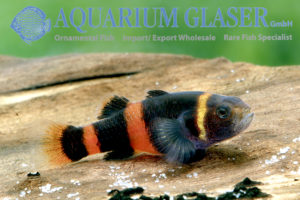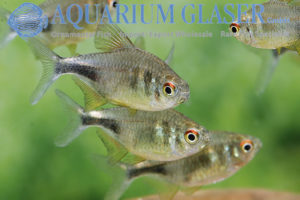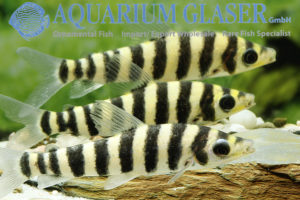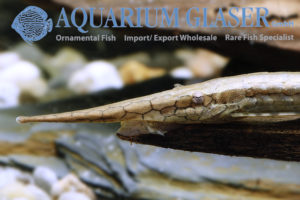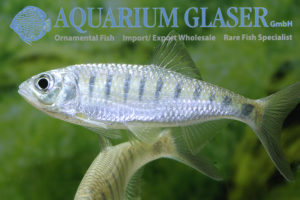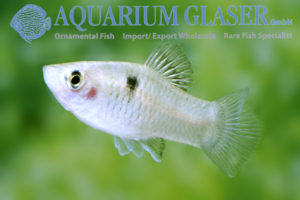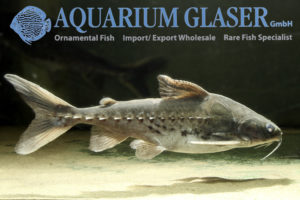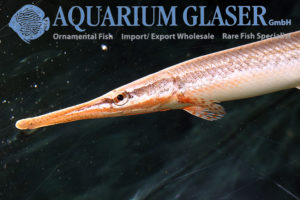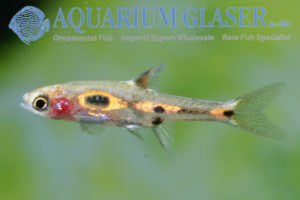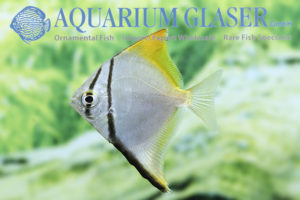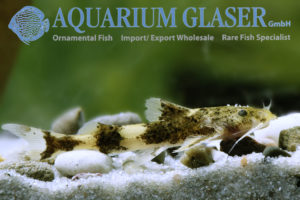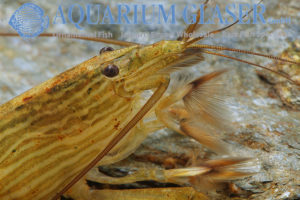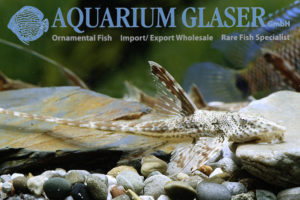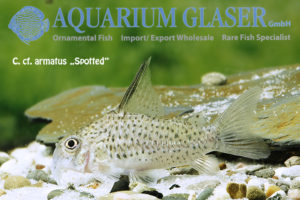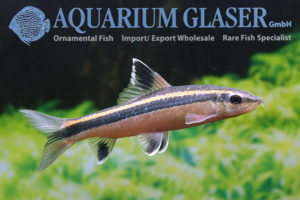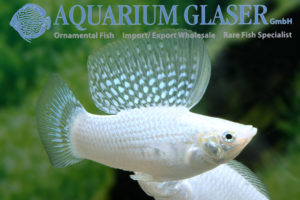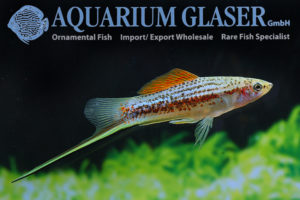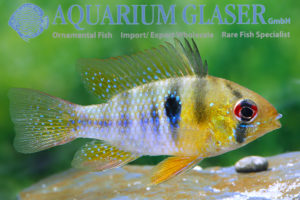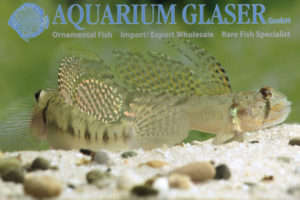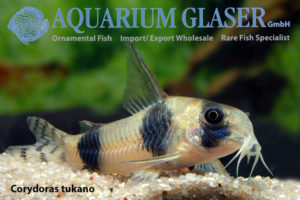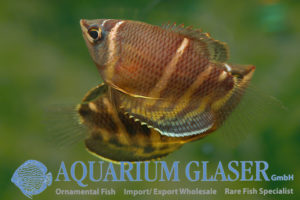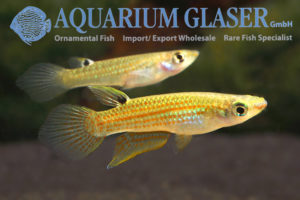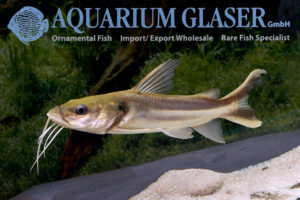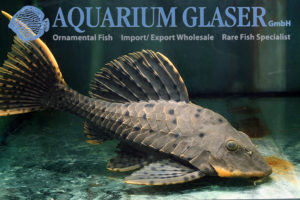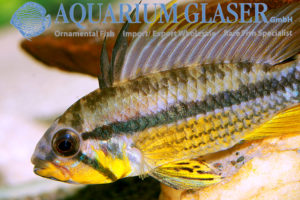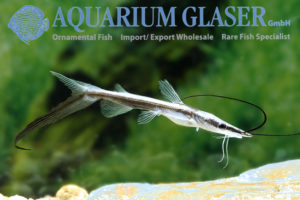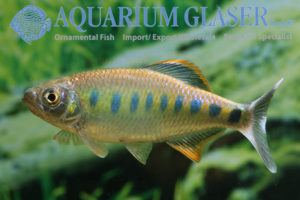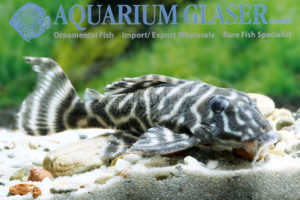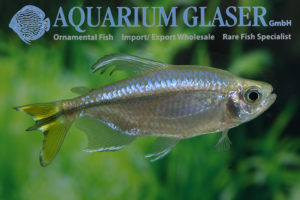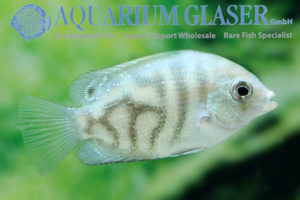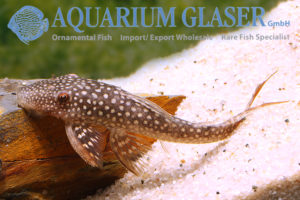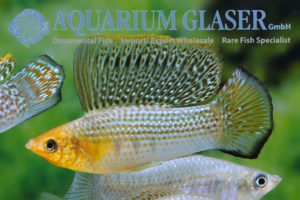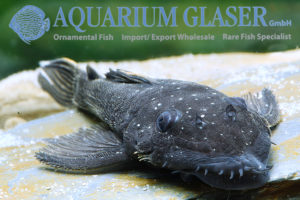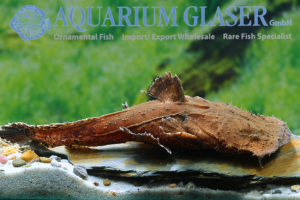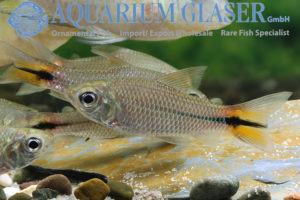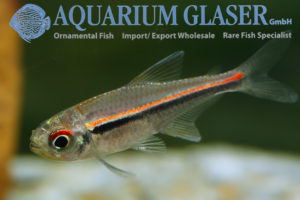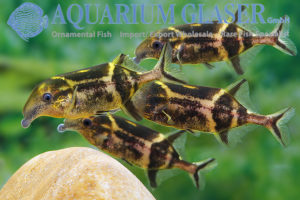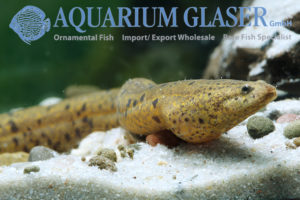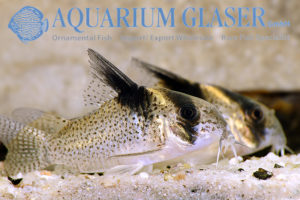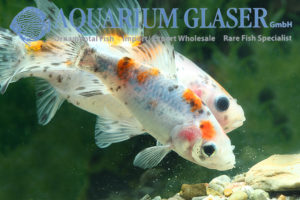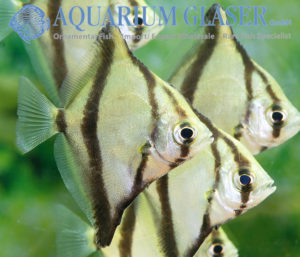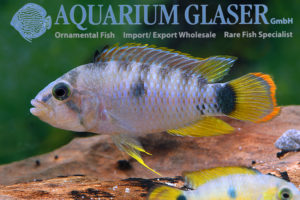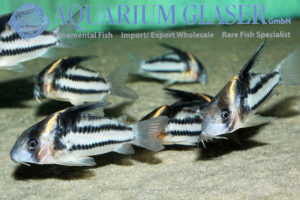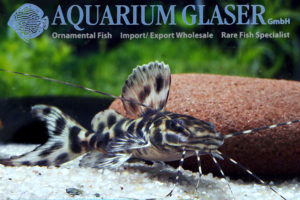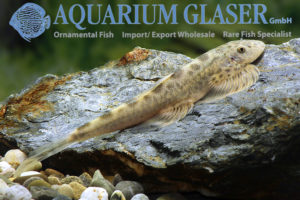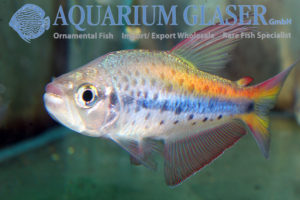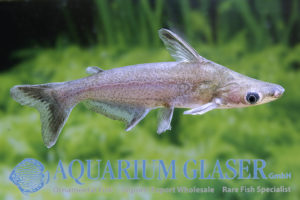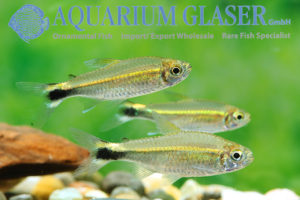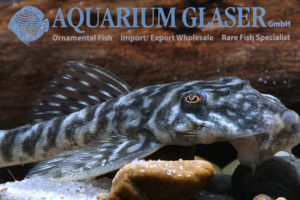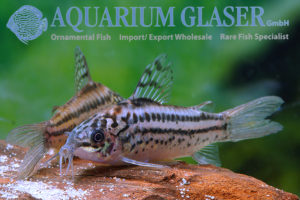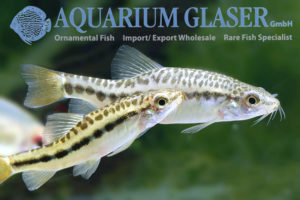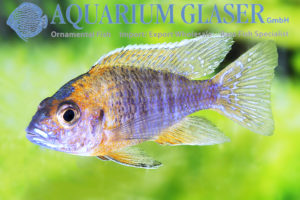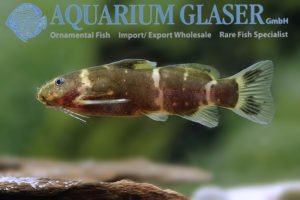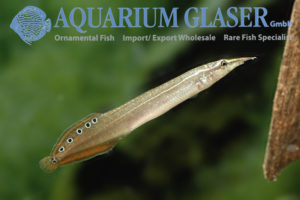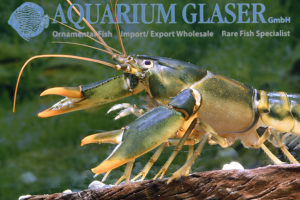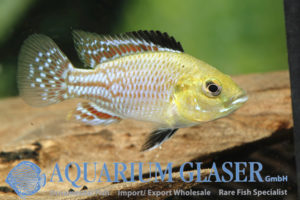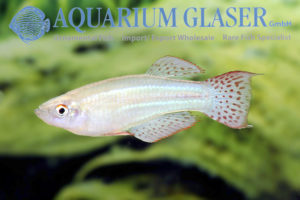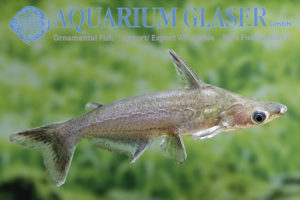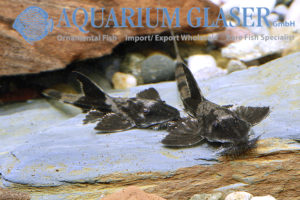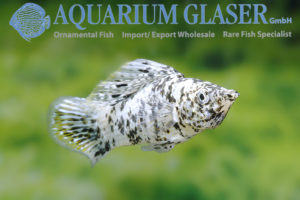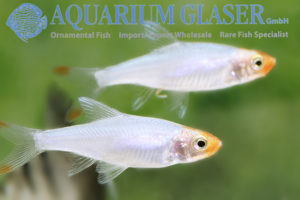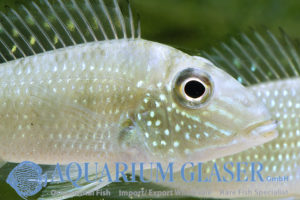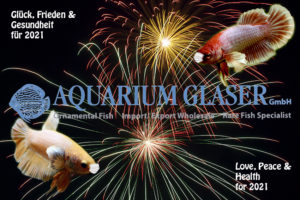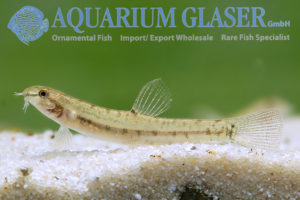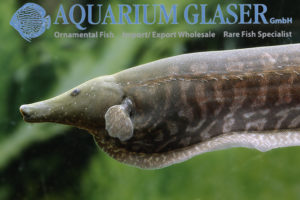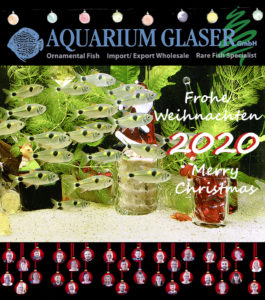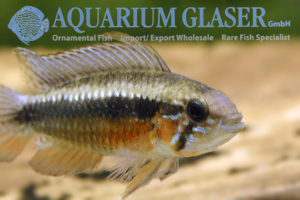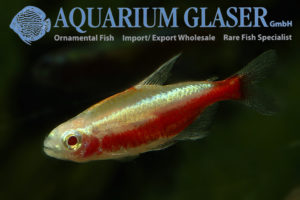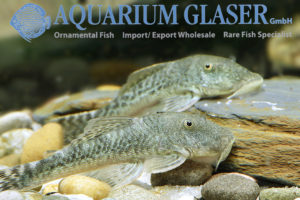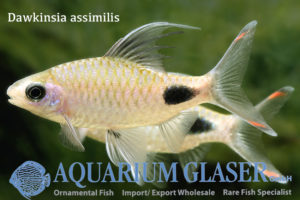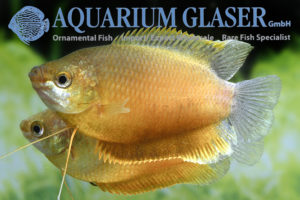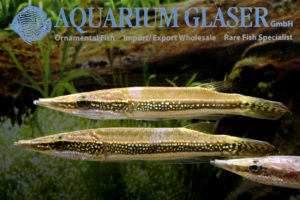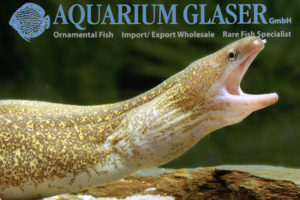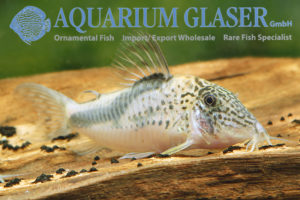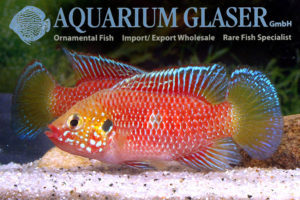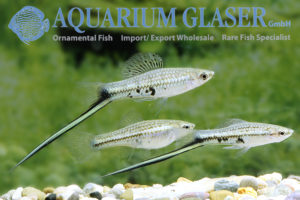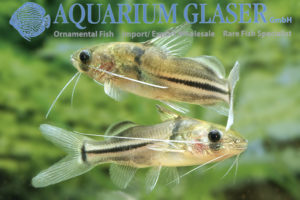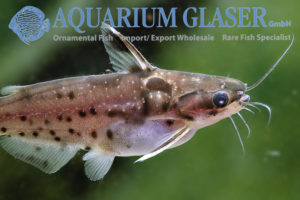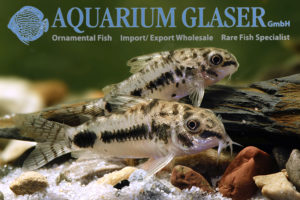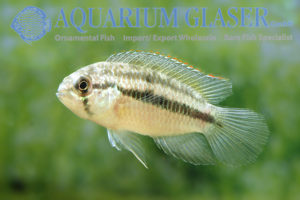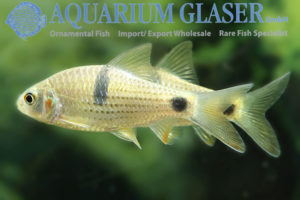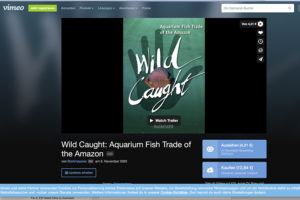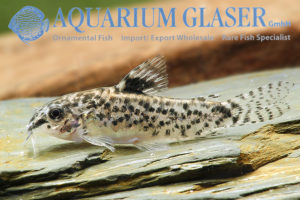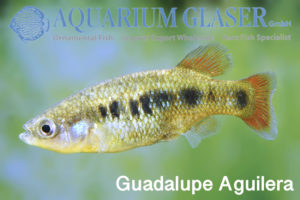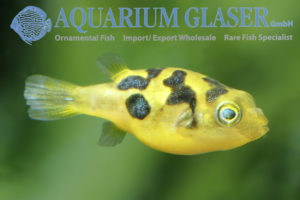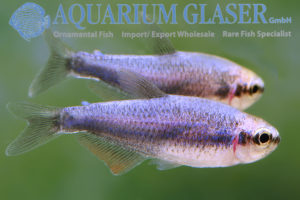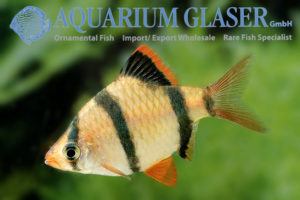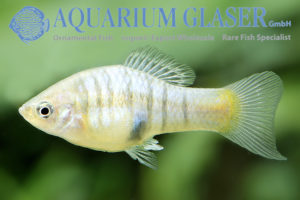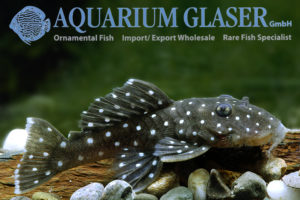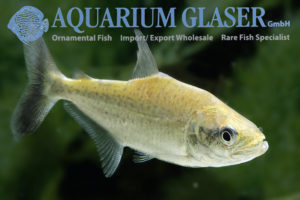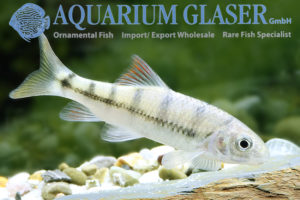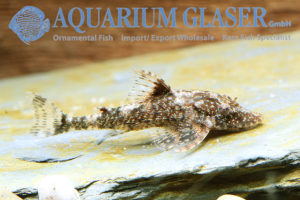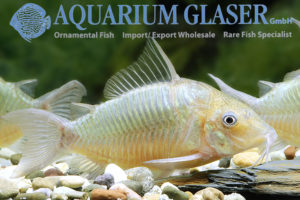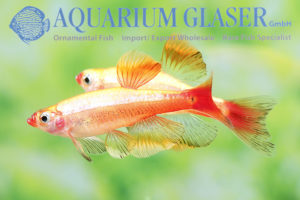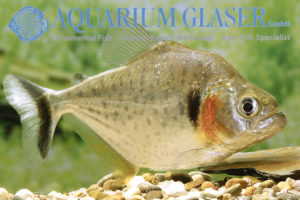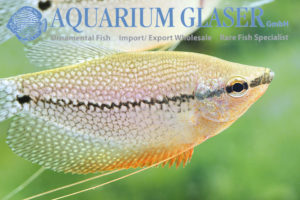In the meantime it has turned out that these animals are Mylesinus paucisquamatus from the Rio Tocantins and the statement that they came from the Rio Xingu was a mistake. New species of large fish are still being found in the rivers of South America, despite they have been well studied. This is mainly due […]
Fish Archive (2963)
-
-
Aphyosemion australe
The “Cape Lopez” (Aphyosemion australe) is one of the longest serving killifishes. It was discovered due to aquarium imports from Gabon (Ogooué River estuary, Port-Gentil, Cape Lopez, northwestern Gabon), from where it was first brought in 1913. In 1921 Arthur Rachow described it as a new species, then cautiously as Haplochilus calliurus var. australis. The […]
-
Bagrichthys macracanthus
We have received juveniles of the “Black Lancer” from Indonesia. The adult fish is pitch black with a white caudal fin and a narrow white horizontal stripe running along the middle of the body. The stripe begins below the dorsal fin and extends into the caudal peduncle. The 4-6 cm juveniles of this up to […]
-
Pyrrhulina brevis
We could import the beautiful species Pyrrhulina brevis already several times from Peru (see https://www.aquariumglaser.de/en/fish-archives/pyrrhulina-brevis-2/). This time they have a very intensive pattern in the anal fin, which reminds of an eye spot and corresponds with a similar pattern in the caudal fin. They are magnificent fish! For our customers: the animals have code 286754 […]
-
Brachygobius doriae
This is probably the most beautiful species of the bumble bee gobies, because the males (also some females) develop a splendid orange-red in the rear half of the body. The females are mostly yellow in color, but they are easily recognized by the comparatively smaller head regardless of coloration. The species was and still is […]
-
Hemigrammus pulcher
From the upper Amazon in Peru comes the beautiful garnet tetra, which grows 3-4 cm long. The very peaceful animal actually has characteristics like a carbuncle, a gemstone, which in fairy tales has the ability to make the owner invisible: because the eye and tail root of Hemigrammus pulcher shimmer like gemstones, but the individual […]
-
Leporinus fasciatus
The tetras of the genus Leporinus (the genus name is a derivative of the Latin word “lepus” for “hare”) belong to the characteristic river fishes of South America. They owe their name to the shape of their mouth in combination with the elongated “hare teeth” in the lower jaw of some species, which reminded the […]
-
Farlowella amazonum
The needle catfishes (Farlowella) are one of the most species-rich genera within the whiptail catfish relationship with currently 30 recognized species. The species look very similar to each other. Distinguishing features are mainly the arrangement of the bony shields along the flanks and on the abdomen, which is naturally hard to recognize on the living […]
-
Opsarius barna
If you like Danios you will love Opsarius! They are lively, very elegant swimmers, more similar in behavior and appearance to trout than to other danios. As a popular collective name for the group, which includes the genera Opsarius, Barilius, Raiamas and Opsariichthys with a total of about 70 species in Asia and Africa, “Trout […]
-
Xiphophorus maculatus “Tabasco”
Hearing the name Tabasco, the first thing that comes to mind for a Central European is the spicy chili sauce. However, the Platy (Xiphophorus maculatus) that bears this name is neither particularly fiery nor particularly red – it merely originates, like the chili sauce, from the Mexican state of Tabasco, where this population was first […]
-
Lithodoras dorsalis
The genus Lithodoras belongs to the thorny catfishes (Doradidae). There is only one species scientifically described, which has its distribution in South America: L. dorsalis, which inhabits the Amazon basin; in addition, the species was reported from a creek near Cayenne (French Guiana), but the latter occurrence still needs confirmation. The maximum length of L. […]
-
Red Gars
From Indonesia we have received captive bred specimens of a gar species, which stands out due to its reddish brown (normally blackish, gray or silver) basic coloration with partly brick-red coloration parts. Unfortunately, it is not possible for us to name the species correctly, because the reliable identification of gar is only possible on the […]
-
Boraras merah
Currently we have very nice Boraras merah in stock. The species is a very close relative to B. brigittae and at least in some populations the females of B. merah look like B. brigittae and only the males have a typical B. merah pattern (see also http://www.aquariumglaser.de/en/boraras-brigittae–boraras-merah_de_1107.html). Cross-breeding experiments also show that both varieties are […]
-
Monodactylus argenteus
Moonies are magnificent brackish water fish. In pure fresh water they should be kept only temporarily, if possible, because they are very sensitive there. If it has to be freshwater, then the pH value must not drop below 7 and the nitrate value must not rise above 50 mg/l, nitrite is harmful even in very […]
-
Glyptothorax cf. housei
The belly sucker catfishes (Glyptothorax) are almost unknown in aquaristics. It is a very species-rich group (over 100 accepted plus probably still numerous undescribed species) of mostly small, current-loving catfishes. The extremely sparse care experiences with these catfishes show that they are (as with many stream fishes) sensitive animals, which tolerate neither stronger organic pollution […]
-
Atyopsis moluccensis
Among the numerous shrimp species that have gained a firm foothold in the hobby are two larger species of fan shrimp, namely Atyopsis moluccensis, the Moluccan mountain rock shrimp from Southeast Asia, and Atya gabonenis, the Gabon giant fan shrimp from West Africa. They grow relatively large (A. moluccensis approx. 9 cm, A. gabonensis approx. […]
-
Rineloricaria heteroptera
From Brazil we received beautiful whiptail catfishes, which we thought at first sight to be Rineloricaria lanceolata, a species with a very wide distribution. The high proportion of reddish animals was striking. The majority of the fish are small, 3-4 cm long and marked like R. lanceolata, but there are a few adult specimens among […]
-
Corydoras cf. armatus “Spotted Putumayo“
From Colombia we received a nice Corydoras species, which threw us into some confusion during identification. They were sent as C. armatus, a species described from the Rio Huallaga, a right-bank tributary of the Rio Maranon (the larger of the two headwaters of the Amazon) in Peru. C. armatus is a conspicuously high-backed species with […]
-
Epalzeorhynchos kalopterum
The Flying Fox, Epalzeorhynchos kalopterum (Epalzeorhynchos is neuter, so if the species name is an adjective – as in this case – it must end in the Latin neuter suffix -um), originates from Indonesia, Malaysia and Thailand, where it is a resident of flowing waters that carry deep dark brown black water. They are probably […]
-
Poecilia velifera Silver
Silver mollies are among the most popular livebearers. Most of the silver mollies in the trade are a breeding form of Poecilia latipinna. Since the species Poecilia latipinna, P. sphenops, P. mexicana and P. velifera can be crossed and color characteristics and certain fin shapes (e.g. lyratail) are transferred to the hybrid young, the desired […]
-
Xiphophorus hellerii “Yucatan 2”
From a German breeder we received this extraordinarily attractive wild form of the swordtail. Unfortunately we could not find out where exactly and by whom these animals were collected. It could only be determined that they were originally brought from Yucatan (Mexico). As a distinction to the completely different looking X. hellerii “Yucatan” (see https://www.aquariumglaser.de/en/fish-archives/xiphophorus_hellerii_yucatan_en/) […]
-
Mikrogeophagus ramirezi wild
Because of the enormous popularity of the butterfly cichlid or blue ram (Mikrogeophagus ramirezi), there are mainly offspring and breeding forms on the market. Also the wild-colored offsprings differ clearly from the wild species: they are considerably larger (4-5 cm body length without caudal fin compared to 2-3 cm with wild-caught fish) and at the […]
-
Oligolepis acutipennis
Oligolepis acutipennis is one of the most widespread gobies of the Indo-West Pacific. The species, which can grow up to 15 cm long, is distributed from South Africa via East Africa, the Persian Gulf, Madagascar, Indonesia and along the entire coast of Southeast Asia to Japan. From this wide distribution one can easily conclude that […]
-
Corydoras reynoldsi & Corydoras tukano
Corydoras reynoldsi is a pretty cory catfish that has been described in 1960. It was collected in the Caquetà province, eastern Colombia. It remained unknown in the hobby quite long, as this area is far away from the usual collecting areas. In 1997 the cory enthusiasts became aware of another, quite similar species of Corydoras […]
-
Sphaerichthys osphromenoides
The chocolate gourami (Sphaerichthys osphromenoides) still belongs to the legendary ornamental fish species. Although the species is common in the wild and other fish of the same habitat (e.g. harlequin barbs) do not cause significant problems in the aquarium, it is a gamble whether chocolate gouramis will do well there. Possibly this is related to […]
-
Aplocheilus blockii
The Green panchax (Aplocheilus blockii) is one of the tiniest and most beautiful species of panchax in Asia. We were able once more to import the species from Kerala (South India). Its maximum length is around 3 cm, at least as far as wild collected specimens are concerned. Aquarium specimens may become a bit larger […]
-
Clarotes laticeps
This is one of the large river catfishes of Africa. We were able to import some specimens once more from Nigeria. However, the species has a very far distribution and is found in the Nile, most parts of West Africa and also in the rivers that flow through the savannahs and riparian forests of East […]
-
Pseudorinelepis sp. L95
Now it is again season for the unfortunately so rarely available Pseudorinelepis sp. L95 from the Rio Demini. And what beautiful animals we got! All specimens are 25-30 cm long. For more information please see https://www.aquariumglaser.de/en/fish-archives/pseudorinelepis-sp-l95-2/ For our customers: the animals have code 26480-L 095-7 on our stocklist. Please note that we supply only wholesale. […]
-
Apistogramma allpahuayo
For a long time this beautiful dwarf cichlid from the basin of the Rio Nanay in Peru sailed under the name “cf. juruensis” or “sp. Black Chin”. Only the scientific description of the species in 2012 put an end to the confusion. Great similarity exists to A. juruensis and A. cacatuoides. From both species living […]
-
Sorubim lima
The large-sized species of the spiny catfishes (Pimelodidae) belong as adult fishes to the desired food fishes and not less desired species for fans of predatory catfishes with giant aquariums. As juveniles, these animals often look completely different and have, for example, absurdly long fin processes. The Shovelnose catfishes of the genus Sorubim are with […]
-
Barilius ardens
Fishes of the genus Barilius are ecologically best compared to trout in the Indian region, where they do not naturally occur. Barilius thus prefer to live in clear waters with a gravelly bottom and some current. They are mostly seen in loose groups, they are not really schooling fish. They like to “play” among themselves, […]
-
Hypancistrus sp. “Nhamunda” L475
The Hypancistrus catfishes with striped pattern are on the one hand a wonderful enrichment for the aquaristics, because they look beautiful, don’t grow too big and can be bred quite well, on the other hand they are constant cause for quarrel. Because in many cases it is hardly possible to determine them exactly. This is […]
-
Alestopetersius caudalis
The Yellow Congo Tetra (Alestopetersius caudalis) originates, as the name suggests, from the Congo. However, it is almost never traded as wild catch, because it can be bred very well. With a final length of about 6 cm it belongs to the smaller species of the Congo tetra relationship. In the course of its aquaristic […]
-
Etroplus suratensis Bred
Mostly we receive the Indian Pearl Cichlid (Etroplus suratensis) as wild catch from South India (formerly also from Sri Lanka) or as German offspring from zoo aquariums. Now, for the first time, we have imported bred ones from Indonesia; some specimens of these offspring do not show a stripe pattern, but have an irregular bow […]
-
Lasiancistrus heteracanthus
We were able to import the rare Red-eyed Deltatail-suckercat, Lasiancistrus heteracanthus, in small numbers from Peru. The species attains a total length of 15-18 cm. Besides the bright red eye the most striking feature of the species is the pretty brown-red lower lappet of the caudal fin. Lasiancistrus, in general, are good algae-eaters and fit […]
-
Poecilia velifera Green
From the sailfin molly, Poecilia velifera, which originates in the hot coastal regions of Mexico, there are mostly cultivated forms in the trade: Golden, chocolate, leopard, dalmatian, black, etc.. The “green” wild form is much rarer, although they are very colorful animals. All sailfin mollies on the market are bred ones. The huge dorsal fin […]
-
Ancistrus macrophthalmus LDA74
From time to time we receive a very flat-bodied Ancistrus from the Orinoco drainage in Colombia and Venezuela under the name of A. ranunculus/L 34. However, this species does not exist there, A. ranunculus is only known from the Amazon tributaries Xingu and Tocantins/Araguaia; the Orinoco species is Ancistrus macrophthalmus, which has received the LDA […]
-
Chaca bankanensis “Sumatra”
This week we received a good number of the interesting frogmouth catfishes of the species Chaca bankanensis from Sumatra. In contrast to the rather reddish animals we could import earlier (https://www.aquariumglaser.de/en/fish-archives/chaca_bankanensis_en/), this time they are rather brown-black colored, probably an origin-related color characteristic. Very interesting is that some animals have striking white colored eyes. At […]
-
Curimatopsis macrolepis
The genus Curimatopsis comprised five described species until 2009 – now (2021) there are more than twice as many, namely 11! Curimatopsis can be divided into two major groups. First the C. macrolepis group with 6 species and second the C. evelynae group with 5 species. The best distinguishing feature of the two groups is […]
-
Hyphessobrycon heterorhabdus
Already in 1894 the three-banded flag tetra (Hyphessobrycon heterorhabdus) was described scientifically; the animals on which the description was based came from the Brazilian state of Pará, more detailed information or illustrations are not available. From 1910 and in the 1920s, when the tetras advanced to the most popular aquarium fishes, also three-banded tetras came […]
-
Campylomormyrus tamandua BRED
Elephant fishes or mormyrids are very interesting and also entertaining fish. They communicate among themselves with electrical signals and have – similar to birds – a relatively well developed cerebellum. Their bizzare body shape makes them additionally interesting. However, they have little to offer in terms of color, mostly coming along in shades of brown […]
-
Synbranchus marmoratus
Only very rarely marbled swamp eels from South America are available. After a quite long time we now have a number of juveniles from Peru in stock. The species attains a maximum length of about 1.5 m. These very large individuals are always males, because swamp eels change their sex. Most of them are born […]
-
Corydoras sp CW 98
This beautiful Corydoras belongs to a scientifically undescribed species. It originates from the upper Rio Negro in Brazil. Because of the bright orange neck spot it is usually misidentified as Corydoras burgessi, which also comes from this region, especially as C. burgessi has a very variable pattern and there are also spotted colour variants of […]
-
Shubunkin
It is and remains the oldest ornamental fish in the world: the goldfish (Carassius auratus) and its many cultivated forms. It has been propagated and kept by humans for about 1,000 years. Many consider goldfish to be garden pond fish, especially the varieties with “nomal”, wild fish-like body types. This is quite true, and they […]
-
Monodactylus sebae
The African Mono is widely distributed along the tropical Atlantic coast of Africa. As a completely euryhaline fish, it can freely change between fresh, brackish and seawater; it prefers to stay in brackish water. In its native range M. sebae is a common fish and is caught there for food. In the past, aquaristic needs […]
-
Apistogramma sp. Oregon
The attractive Apistogramma sp. Oregon comes from the wider surroundings of Iquitos in Peru. Don’t ask us why this one is called “Oregon” – we don’t know that either. It belongs to the closer relationship of A. nijsseni, but differs clearly from this species by the bulky body structure, the large tail spot and a […]
-
Corydoras sp. aff. parallelus CW127
Just as L-numbers are assigned for undetermined loricariids, C- and CW-numbers are assigned for undetermined Corydoras. One of the first species to receive such a number was Corydoras parallelus, which was assigned the number C2 in 1993. In the same year Burgess described it as C. parallelus. The species originates from the upper Rio Negro […]
-
Leiarius marmoratus
There are two species of catfish in South America that look like siblings: Leiarus marmoratus (called “Achara” by the natives) and Leiarius (formerly: Perrunichthys) perruno. Both species attain a length of about 60 cm, have the very same leopard pattern and the long, ringed whiskers. But there does exist an easily recognizable difference: Leiarius marmoratus […]
-
Hemimyzon nanensis
With the import of Hemimyzon nanensis we were once again able to fill a white spot on the map of fishes that have become known in the aquarium with content. At least for us it is a first import. Hemimyzon belongs to the family of hillstream loaches (Balitoridae) and is closely related to the genus […]
-
Pseudochalceus kyburzi
In our last post on this impressive and beautiful tetra species from Colombia, we wrote “This tetra usually grows to around 5 cm long, with 8 cm given as the maximum size.” (https://www.aquariumglaser.de/en/fish-archives/pseudochalceus-kyburzi-4/). Since last week we know, this maximum size can actually be reached! Wow, that’s the first thing we thought of these huge […]
-
Tympanopleura cryptica
For the first time we could (recognized) import this dolphin catfish from Peru. The small species (the biggest scientifically known animal had a standard-length – therefore without tail fin – of barely 8,5 cm) occurs in the area of the upper Amazon, where the river is still called Solimoes. Tympanopleura cryptica was described scientifically only […]
-
Hemigrammus hyanuary Wild
In 1957, when the first Green Tetras or Neon Costello (Hemigrammus hyanuary) were imported, the tetras were absolute fashion fish. Otherwise the comparison with the neon or cardinal tetra can hardly be explained, because H. hyanuary – which by the way is named after Lake Hyanuary in Brazil – is really nicely colored, but it […]
-
Pseudolithoxus kelsorum L189
Unfortunately this interesting catfish from Venezuela is offered only very rarely. It lives in the tributaries of the middle Orinoco. With a maximum length of 10 cm (only very rarely some specimens reach this size, the normal size is 6-7 cm) the species remains relatively small. Pseudolithoxus species are all quite flat, but P. kelsorum […]
-
Corydoras elegans
The armored catfishes of the closer relationship around Corydoras elegans belong to the most interesting species of this huge genus. They do not live as strongly bottom-bound as most other armored catfishes and are very nicely colored. Males and females differ relatively clearly in coloration. However, it is not easy to provide a color description […]
-
Petruichthys brevis (= Yunnanilus brevis)
Petruichthys brevis is a species of loach that originates from Burma. Here it occurs only in Inle Lake. The species attains a length of only 4-5 cm and thus belongs to the small species of fish. In contrast to most other species of loach, this one is a free swimming, schooling species. The swimming behaviour […]
-
Aulonocara “Rubescens”
Do you know the game “Silent Mail”? You play it with at least 10 participants, the more, the better. One of the players thinks up a term and whispers it – inaudible to the others – into the ear of the player next to him. This whispers what he has understood to the next one, […]
-
Microsynodontis batesii
Squeakers or upside-down catfishes are a fish family occurring exclusively in Africa. The best known genus is Synodontis, which comprises over 130 species. Closely related to this genus is the genus Microsynodontis. The genus name means “small Synodontis” and is program, because these fish already become sexually mature with 3-4 cm of length, are thus […]
-
Macrognathus siamensis Red Tail
At the moment we can once again offer very beautiful – i.e. strongly colored – offsprings of a dwarf spiny eel, which is not yet precisely identified. It is offered under the name Macrognathus aculeatus, but for various reasons it will probably not be this species. It shows the most similarity to Macrognathus siamensis, because […]
-
Cherax snowden
The diversity of the crayfishes of New Guinea is hard to keep track of. Most difficult is the decision, whether a freshly imported form is a color variant of a long known species or a new species; because the color variance within the species is enormous. Cherax snowden was known as Cherax sp. “Orange Tip” […]
-
Pseudocrenilabrus nicholsi
This dwarf mouth-breeder comes from the middle and upper Congo, from where ornamental-fish-imports almost never reach us. Pseudocrenilabrus nicholsi is therefore only available as bred ones. The males are beautiful, the females are rather plain colored. The maximum length is about 7 cm, but also this size is reached rather rarely; the photographed, sexually mature […]
-
Procatopus aberrans
We obtained very nice Procatopus aberrans from Nigeria. These lampeyes are very peaceful schooling fish that live near the water surface or at least in the upper third of the water column. In contrast to most other species of lampeye that have an iridescent blue zone in the iris, in P. aberrans the iridescent zone […]
-
Tympanopleura cryptica
For the first time we could (recognized) import this dolphin catfish from Peru. The small species (the biggest scientifically known animal had a standard-length – therefore without tail fin – of barely 8,5 cm) occurs in the area of the upper Amazon, where the river is still called Solimoes. Tympanopleura cryptica was described scientifically only […]
-
Lorcaria simillima Bred
Loricaria simillima has a very wide distribution in South America. It is found in the Orinoco-, Amazon- and La Plata basins. A result of this large area many different color forms are known, which differ clearly regarding coloration and pattern. The species occurs in different water types. Black water forms are more demanding in maintenance […]
-
Poecilia velifera “Dalmatiner”
At least three species of mollies are the parent species of the numerous breeding forms that exist of these fish today: Poecilia sphenops, P. latipinna, and P. velifera. Possibly P. mexicana was also involved, but this is unclear, as this species was long considered a synonym of P. sphenops. Some color and fin characteristics could […]
-
Sawbwa resplendens
Lake Inle in Burma is a mountain lake located on the Shan Plateau about 900 meters above sea level; it is about 65 km long and 10-22 km wide. The water is relatively hard (12-17° GH) and in February the water temperatures drop to 14-18°C. Lake Inke is world-famous for its human inhabitants, whose entire […]
-
Satanoperca sp. aff. jurupari “Tapajos”
Some of the earth-eaters of the genus Satanoperca have frightening names (Satanoperca = devil-perch, Jurupari = devil, Daemon = demon, Lilith = the bride of the devil), but there are only few cichlids that are as peaceful and harmless as they are. The most important thing they need in an aquarium is a part of […]
-
A perfect start
and a happy, successful and healthy New Year 2021 wishes you the whole team of Aquarium Glaser
-
Lepidocephalichthys kranos
For the first time we can offer these cute dwarf spined loach from Vietnam. They become (without caudal fin) at most 3,5 cm long. Lepidocephalichthys kranos was not recognized as an independent species until 2010. The species differences in Lepidocephalichthys are very subtle (otherwise they would have been scientifically identified earlier), but it is quite […]
-
Rhamphichthys rostratus
Since some time we can offer a very interesting knife-fish species of the genus Rhamphichthys, which we receive as offspring from Indonesia. Rhamphichthys are attractive fish, but they require strong nerves from their keeper, because they rest lying on their side and look like dead at first sight. But they are very happy, only sleeping. […]
-
Exodon paradoxus
For many aquaristis the Bucktooth tetra, Exodon paradoxus, is simply the most beautiful tetra from South America. The splendid fish glitter and glimmer like diamonds and they never stay still. They hunt and hit their conspecifics permanently and an uneducated watcher may become quite concerned that the fish will eventually hurt each other. But this […]
-
Apistogramma elizabethae
This wonderful dwarf cichlid belongs to the rarest and most wanted species of Apistogramma in the trade. Nevertheless the animals are not very difficult to keep at all. If the fish is kept under the correct conditions it belongs to the hardier species of the genus. There do exist elder reports on the fish that […]
-
Paracheirodon axelrodi “Gold”
The cardinal tetra, Paracheirodon axelrodi, is one of the most traded ornamental fish worldwide. It is a big exception in the ornamental fish trade, because it was mainly traded as a wild catch; it is different with almost all other important ornamental fishes, which are mainly or exclusively traded as bred ones. It is said […]
-
Chaetostoma joropo (L445)
The dotted Chaetostoma joropo is already for many years a popular sucker-catfish. Before its scientific description in the year 2016 it was given several names, e.g. sp. Spotted, cf. milesi, Villavicencio I, L187a etc. It originates from creeks in the catchment area of the Rio Meta in Colombia and therefore does not need to be […]
-
Dawkinsia assimilis
The so-called filament barbs of the genus Dawkinsia were assigned earlier all together to the types Barbus or Puntius. They received the popular name because the back-fin of the males with its long fin-rays. The differentiation of the species is extraordinarily tricky, although several scientists tried in the last decades at them. Only a few […]
-
Colisa labiosa “Orange”
The identity of Colisa labiosa, a gourami from Burma, is unclear; there is some evidence that the species so named in the hobby is actually not identical with C. labiosa in the sense of the first describer (Day, 1877), but it is much more likely that it is a scientifically not yet named species. But […]
-
Luciocephalus aura
The pikeheads (Luciocephalus) are highly specialized labyrinth fish. They live as predators in blackwaters of Southeast Asia. Only two species are known, the “common” pikehead, which occurs on the Malay Peninsula and in Indonesia, and the Peppermint Pikehead, which is known so far only from the Province Jambi on Sumatra. Currently we are able to […]
-
Gymnothorax tile
For many years the up to 60 cm long moray eel species Gymnothorax tile has been sold as “freshwater moray”. It is true that G. tile can live in pure fresh water for a while (a few months) without showing any discomfort. But practice shows that this moray eel species is much more persistent in […]
-
Corydoras fowleri German bred
Corydoras fowleri from Peru becomes 6-8 cm long and certainly belongs to the most beautiful Corydoras at all. Nevertheless, the species is only rarely bred, because the eggs are relatively small and the fish – despite their size – relatively unproductive. Therefore we are especially pleased to be able to offer wonderful German bred ones […]
-
Hemichromis sp. Red Gabon
Red Jewel Cichlids are gorgeous fishes. Their splendid coloration can be hardly topped. And they have a fascinating behaviour. They form a biparental family, both male and female take carefor the offspring together. No real hobbyist can hestitate to be banned by that look. The only negative aspect of these fishes is: they can be […]
-
Xiphophorus montezumae
With the swordtails (Xiphophorus), the males carry a sword-like extension at the low end of the tail fin in many species. This is a luxury structure, that serves the intraspecific communication. Sword-bearing males appear especially sexy on the females and especially intimidating on male conspecifics. The also with primates (the ape-like animals) well known game […]
-
Brachyrhamdia meesi
The genus Brachyrhamdia includes only five described species, another one, that is still scientifically undescribed, was imported over 10 years ago as accidental catch, since then, one heard nothing more of it. Brachyrhamdia are relatively small-growing catfish. Brachyrhamdia meesi comes from Brazil and grows to about 8 cm in length. Like all species of the […]
-
Auchenipterichthys punctatus
It was believed for quite a long time that the genus Auchipterichthys would contain only one or two, very far spread species. In 2005 Ferraris, Vari, and Raredon revised the genus and could show that in reality four different species are involved. The species that was thought so far to be the most common in […]
-
Corydoras habrosus
Now it is season for the cute chessboard dwarf cory, Corydoras habrosus. The fish grows to a maximum of four centimeters. It is completely peaceful and leaves the plants in peace, so it is very suitable for community aquariums. The usual care-recommendations for Coryoras are valid, which means they should be kept in groups and […]
-
Nannacara sp. “Crique Canceler”
The Goldeneye cichlid (Nannacara anomala) is a classic among aquarium fish. Already 80 years ago this species taught the aquarists what emancipation means, because here the female is the absolutely dominant fish. And the female often is only half as big as the maximum 8 cm long male. Dwarf cichlids from the closer relationship of […]
-
Systomus binduchitra
For the first time we could import this beautiful barb from Burma. The largest scientifically known specimen of Systomus binduchitra (the species name comes from Sanskrit and means “spotted”) was 8 cm long including tail fin. Due to its close relationship to S. sarana, it can be assumed that it will probably grow somewhat larger […]
-
Complete documentation about the advantages of the wild caught ornamental fish in Amazonia now available
Again and again it is circulated that the wild caught of ornamental fish threatens species and the diversity of species, is predatory exploitation of nature. However, there are no scientific studies that would prove this. All scientifically founded, serious work on the topic proves the opposite: Wild caught of ornamental fish is a clean thing! […]
-
Aspidoras pauciradiatus
This cute dwarf armored catfish reaches a maximum length of only 3 cm. Aspidoras pauciradiatus comes from the central Rio-Negro area and is an ideal community fish for characins, dwarf cichlids etc. Strangely enough, the specimens on which the scientific description is based were allegedly collected in the Rio Araguaia near the town of Aruana, […]
-
Characodon audax Puente Pino Suarez and Guadalupe Aguilera
Several goodeids are a parade play for the fact that conservation of species in captivity by hobby aquarists is possible and partially extraordinarily successful. The species Charcodon audax occurs endemically (i.e. exclusively there) in parts of the catchment area of the headwaters of the Rio Mezquital in the Mexican state of Durango. It is threatened […]
-
Carinotetraodon travancoricus
The first Indian dwarf puffer fish (Carinotetraodon travancoricus) of the new season have arrived. These cute animals – they are freshwater puffers – only grow 2-3 cm long in nature, in the aquarium they may grow a little bigger, but not much. You should keep these animals in a swarm if possible; then they form […]
-
Inpaichthys kerri “Super Blue”
There is a nice story about the discovery of the king tetra, which we don’t know if it’s true, but it’s worth telling: In the Instituto Nacional de Pesquisas da Amazônia (INPA), Manaus, Brazil, aquatic plants were kept in an aquarium. Fish were actually not in it. But suddenly, as if from nowhere, cute baby […]
-
Puntigrus anchisporus – tiger barb
No other classic aquarium fish has had to put up with such a drastic renaming regarding the scientific name as the tiger barb. This is due to the fact that in earlier decades, characteristics that we now consider important species characteristics were only considered an unimportant variance. The actual tiger barb, Puntigrus tetrazona, which comes […]
-
Xiphophorus xiphidium
The sword platy, Xiphophorus xiphidium, belongs to the top rarities among the live-bearers. The species is found on the headwaters of the Soto La Marina River and its tributaries, Tamaulipas State, on the Atlantic side of Mexico. The very pretty species remains with approx. 3 cm (male) resp. 4 cm (female) clearly smaller than the […]
-
Parancistrus nudiventris, L31, LDA4, Peppermint Pleco
This pleco from the Rio Xingu is an old friend, however, it received a scientific name only in 2005. It received the L-number 31 already in 1989. The genus Parancistrus is closely related to the genus Spectracanthicus; the formerly often used genus Oligancistrus is invalid and declared synonymous with Spectracanthicus. The only difference between Parancistrus […]
-
Serrasalmus elongatus
This very elongated Piranha can be confused hardly with other species because of its characteristic body shape. Type locality is the Rio Guaporé, Mato Grosso, Brazil. Aquaristic imports are mostly from Peru. Serrasalmus pingke from Venezuela was described from the Rio Apure. The holotype (54 mm long) is shown in MACHADO-ALLISON (2002); it has a […]
-
Acrossocheilus paradoxus
Only rarely does the pretty barbel Acrossocheilus paradoxus reach us, which is native to China and Taiwan. It is a medium sized species; in the wild you usually find specimens up to 12 cm total length, but the record for this species is 22.5 cm. Such large animals look different, the head is longer and […]
-
Parotocinclus eppleyi
One of the smallest loricariid species at all is Parotocinclus eppleyi, the Peppermint-Oto. The species is fully grown with a length of 3 cm (without caudal fin), but such animals can already be seen as xxl-format and are extremely rare. Usually the species, which is common in the upper and middle Orinoco, is 0.5-1 cm […]
-
Brochis splendens “Rio Negro
Via Manaus we have been able to import splendid Brochis splendens. The Emerald Cat comes from a huge area, from Peru to the Pantanal in Brazil; based on the experience with other Corydoras it is more than likely that there are several species hiding behind the name “Brochis splendens”. But such things should be subject […]
-
Tanichthys “Gold Longfin“
Since its first import in the 1930er years, the White Cloud Mountain minnow (Tanichthys albonubes) is available practically exclusively as offspring for the aquarium hobby. Nowadays, this is all the more true since the free-living stocks are considered highly endangered due to environmental pollution. However, the “simple” white cloud is not really bred by most […]
-
Serrasalmus humeralis
The identification of many Piranha species is difficult. One of the earliest described piranha species and therefore with many taxonomic problems is Serrasalmus humeralis. Valenciennes was the first descriptor in 1850, but there is no question that he had received the type specimen, for which he states “Amazon” as the type locality, from Castelnau. In […]
-
Trichogaster leerii WILD – Borneo
The pearl gourami (Trichogaster leerii, Trichopodus leerii) is one of the most popular aquarium fishes at all. It is probably not exaggerated if one assumes millions of individuals in aquariums all over the world. All these fish are bred ones. It is only little known that the pearl gourami belongs to the endangered species as […]
- « Previous Page
- 1
- …
- 5
- 6
- 7
- 8
- 9
- …
- 30
- Next Page »





